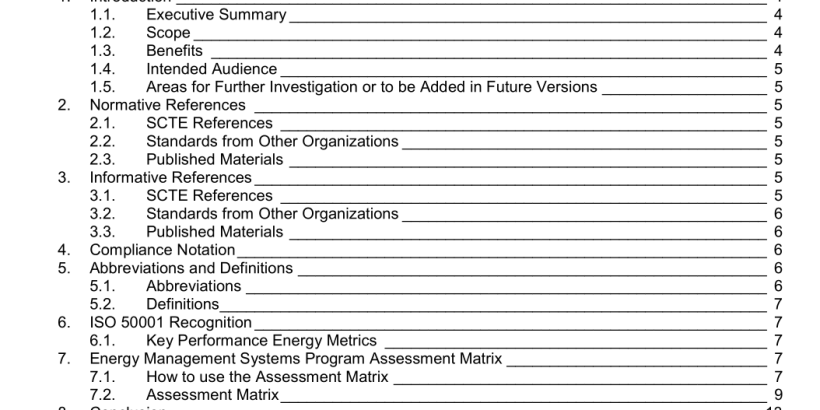ANSI SCTE 234-2016 pdf download.ISO 50001:2011 Energy Management Systems, Energy Metrics, With Guidance For Use
1.1. Executive Summary
SCTE’s Energy 2020 Program is a multi-year campaign that aims to provide cable system operators with the energy management standards, technology innovation, organizational solutions and training that look to help the cable industry meet Energy 2020’s goals. In 2011 the International Organization for Standardization (ISO) published 50001: Energy management systems — Requirements with guidance for use. SCTE’s Energy 2020 Program aligns with the underlying principles of that publication and SCTE 234 2016 serves as the recognition of that international standard as the official cable industry standard.
1.2. Scope
ISO 50001:2011 specifies requirements for establishing, implementing, maintaining and improving an energy management system, whose purpose is to enable an organization to follow a systematic approach in achieving continual improvement of energy performance, including energy efficiency, energy use and consumption. ISO 50001:2011 specifies requirements applicable to energy use and consumption, including measurement, documentation and reporting, design and procurement practices for equipment, systems, processes and personnel that contribute to energy performance. ISO 50001:2011 applies to all variables affecting energy performance that can be monitored and influenced. ISO 50001:2011 does not prescribe specific performance criteria with respect to energy, however the cable industry has come together to publish its performance criteria in the SCTE Standards supporting Energy 2020 found at http://www.scte.org/SCTE/Areas_of_Interest/SCTE_Energy_Standards_and_Operational_Practices.aspx ISO 50001:2011 is applicable to any company in the cable industry wishing to develop an energy policy and ensure that business practice conforms to its stated energy policy and wishing to demonstrate this to others, such conformity being confirmed either by means of self-evaluation and self-declaration of conformity, or by certification of the energy management system by an external organization.
1.3. Benefits
Energy 2020 and the recognition of ISO 50001 enables companies in the cable industry to hedge growing energy costs and power availability challenges, and sustain those benefits over the long term. Adoption of ISO 50001 specifically will enable the following short and long term benefits:
– Reduced environmental impact
– Increased transparency on how energy resources are managed
– Identification of future projects that will integrate into your new structure
– Promotion of energy efficiency throughout the cable operator’s organization
– Improved positive external relations and public image
– Increased awareness and greater employee energy stewardship
– Reduced air emissions, such as greenhouse gases
– Increased assurance of internal energy use compliance
– Increased understanding of energy use and consumption via defined methods, metrics, goals and processes of data collection
– Reduced maintenance costs from better managed IT and cooling equipment
– Increased capacity in facilities by improved power utilization
2. Normative References
The following documents contain provisions, which, through reference in this text, constitute provisions of this document. At the time of Subcommittee approval, the editions indicated were valid. All documents are subject to revision; and while parties to any agreement based on this document are encouraged to investigate the possibility of applying the most recent editions of the documents listed below, they are reminded that newer editions of those documents might not be compatible with the referenced version.
4. Compliance Notation
Shall This word or the adjective “required” means that the item is an absolute requirement of this document. shall not This phrase means that the item is an absolute prohibition of this document. Forbidden This word means the value specified shall never be used. Should This word or the adjective “recommended” means that there may exist valid reasons in particular circumstances to ignore this item, but the full implications should be understood and the case carefully weighted before choosing a different course. should not This phrase means that there may exist valid reasons in particular circumstances when the listed behavior is acceptable or even useful, but the full implications should be understood and the case carefully weighed before implementing any behavior described with this label. May This word or the adjective “optional” means that this item is truly optional. One vendor may choose to include the item because a particular marketplace requires it or because it enhances the product, for example; another vendor may omit the same item. Deprecated Use is permissible for legacy purposes only. Deprecated features may be removed from future versions of this document. Implementations should avoid use of deprecated features.ANSI SCTE 234-2016 pdf download
